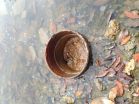The study by Scott C. Bunce, PhD, of Penn State University College of Medicine, Hershey, and colleagues provides evidence of "physiological re-regulation" of disrupted brain and hormonal responses to pleasurable stimuli--both drug- and nondrug-related.
Signs of Reward System Disruption After Drug Withdrawal... The pilot study included two groups of seven patients in residential treatment for dependence on opioid pain medications. One group had recently gone through medically assisted opioid withdrawal--within the past one to two weeks. The other group was in extended care, and had been drug-free for two to three months. A group of normal controls were studied for comparison.
The researchers performed several tests to assess changes in the "brain reward system" during early recovery. After drug withdrawal, many people with opioid dependence have "persistent changes in the reward and memory circuits"--they may experience heightened "rewards" or "pleasure" in response to drugs and related stimuli, but greatly reduced responses to naturally pleasurable stimuli (such as good food, or friendship).
Dr Bunce explains, "This is thought to occur because opiates are potent stimulators of the brain's reward system; over time, the brain adapts to the high level of stimulation provided by opiates, and naturally rewarding stimuli can't measure up." Such dysregulation of the natural reward system may contribute to the high risk of relapse during recovery.
The test results showed several significant differences in the reward system between groups. A test of startle reflexes showed that patients with recent drug withdrawal had reduced pleasure responses to "natural reward" stimuli--for example, pictures of appetizing foods or people having fun.
In brain activity studies, patients with recent drug withdrawal showed heightened responses to drug-related cues, such as pictures of pills. In the extended-care patients, these increased responses to drug cues--in a region of the brain called the prefrontal cortex, involved in attention and self-control --were significantly reduced.
...May Lead to New Objective Measures of Recovery Patients who had recently withdrawn from opiates also had high levels of the stress hormone cortisol (adrenaline). In the patients who had been drug-free for a few months, cortisol levels were somewhat reduced, although not quite as low as in healthy controls. The recently withdrawn group also had pronounced sleep disturbances, while sleep in the extended care group was similar to controls.
All of these changes--brain and hormonal responses to drug cues and natural rewards, as well as sleep disturbances--were correlated with abstinence time. The more days since the patient used drugs, the lower the abnormal responses.
The study supports past research showing dysregulation of the reward system during early recovery from opioid dependence. It also provides evidence that these responses may become re-regulated during several weeks in residential treatment--a period of "clinically documented" abstinence from opioids.
That's a potentially important step forward in addiction medicine research, Dr Bunce believes. "It shows that if the patient remains in treatment and off drugs for several months, the body's natural reward systems may have the capacity to return toward normal, making it easier for them to remain drug-free outside the treatment setting." With further study, tests of the natural reward system might provide useful, objective markers of recovery--clinical tests that help to evaluate how the patient's recovery is proceeding.
Such tests might help in managing the difficult problem of prescription opioid dependence--an ongoing epidemic associated with a high risk of relapse after drug withdrawal. Dr Bunce and colleagues are conducting a follow-up study, funded by the National Institute on Drug Abuse, to determine whether measures of the brain's reward system, sleep and the stress response system indicate the capacity for re-regulation and the patient's risk of relapse during recovery.
INFORMATION:
Click here to read "Possible Evidence for Re-regulation of HPA Axis and Brain Reward Systems Over Time in Treatment in Prescription Opioid-Dependent Patients."
About Journal of Addiction Medicine
The mission of Journal of Addiction Medicine, the official journal of the American Society of Addiction Medicine, is to promote excellence in the practice of addiction medicine and in clinical research as well as to support Addiction Medicine as a mainstream medical specialty. Published quarterly, the Journal is designed for all physicians and other mental health professionals who need to keep up-to-date with the treatment of addiction disorders. Under the guidance of an esteemed Editorial Board, peer-reviewed articles published in the Journal focus on developments in addiction medicine as well as on treatment innovations and ethical, economic, forensic, and social topics.
About The American Society of Addiction Medicine
The American Society of Addiction Medicine is a national medical specialty society of over 3,200 physicians and associated health professionals. Its mission is to increase access to and improve the quality of addiction treatment, to educate physicians, and other health care providers and the public, to support research and prevention, to promote the appropriate role of the physician in the care of patients with addictive disorders, and to establish addiction medicine as a specialty recognized by professional organizations, governments, physicians, purchasers and consumers of health care services and the general public. ASAM was founded in 1954, and has had a seat in the American Medical Association House of Delegates since 1988. Follow ASAM's official Twitter handle: @ASAMorg.
About Wolters Kluwer Health
Wolters Kluwer Health is a leading global provider of information, business intelligence and point-of-care solutions for the healthcare industry. Serving more than 150 countries worldwide, clinicians rely on Wolters Kluwer Health's market leading information-enabled tools and software solutions throughout their professional careers from training to research to practice. Major brands include Health Language®, Lexicomp®, Lippincott Williams & Wilkins, Medicom®, Medknow, Ovid®, Pharmacy OneSource®, ProVation® Medical and UpToDate®.
Wolters Kluwer Health is part of Wolters Kluwer, a market-leading global information services company. Wolters Kluwer had 2013 annual revenues of €3.6 billion ($4.7 billion), employs approximately 19,000 people worldwide, and maintains operations in over 40 countries across Europe, North America, Asia Pacific, and Latin America.maintains operations in over 40 countries across Europe, North America, Asia Pacific, and Latin America. Wolters Kluwer is headquartered in Alphen aan den Rijn, the Netherlands. Its shares are quoted on Euronext Amsterdam (WKL) and are included in the AEX and Euronext 100 indices. Wolters Kluwer has a sponsored Level 1 American Depositary Receipt program. The ADRs are traded on the over-the-counter market in the U.S. (WTKWY).
Follow our official Twitter handle: @WKHealth.


